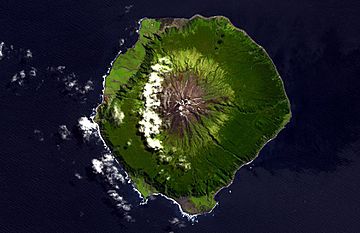Queen Mary's Peak facts for kids
Quick facts for kids Queen Mary's Peak |
|
|---|---|
| Tristan da Cunha | |

Satellite photo of Tristan da Cunha
|
|
| Highest point | |
| Elevation | 2,062 m (6,765 ft) |
| Prominence | 2,062 m (6,765 ft) |
| Listing | Ultra |
| Geography | |
| Location | Tristan da Cunha |
| Geology | |
| Age of rock | 148 ± 8 ka |
| Mountain type | Shield volcano |
| Last eruption | October 1961–March 1962 |
| Climbing | |
| First ascent | About 1 January 1817 |
Queen Mary's Peak is the highest point on the island of Tristan da Cunha. This island is located in the South Atlantic Ocean. The peak reaches an amazing 2,062 metres (6,765 feet) above sea level. It was named after Mary of Teck, who was the Queen consort of King George V. It is also the highest point in the British overseas territory of Saint Helena, Ascension and Tristan da Cunha.
Contents
About Queen Mary's Peak
This mountain is actually the top of a large shield volcano. This volcano created the entire island of Tristan da Cunha. At the very top of the peak, there is a crater that is about 300 metres (980 feet) wide. Inside this crater, you'll find a lake shaped like a heart!
A Volcano with a Lake
The lake inside the crater usually freezes over during the winter months. Also, the higher slopes of the volcano often get covered in snow. This makes for a beautiful, snowy view.
A Brief Eruption
There has only been one volcanic eruption recorded in modern history. This happened in 1961 from a small crater on the northern coast of the island. Because of this eruption, everyone living on the island had to leave for a while to stay safe.
Guiding Sailors
For a long time, Queen Mary's Peak was very important for sailors. It helped them find their way when traveling from Europe to the Indian Ocean and beyond. In the 17th century, the East India Company even told their ship captains to sail past Tristan da Cunha. This way, they could use the peak as a navigational guide.
Climbing to the Top
The first known attempt to climb Queen Mary's Peak was in 1793. A French naturalist named Louis-Marie Aubert du Petit-Thouars tried to reach the top. He didn't make it all the way, but he did collect hundreds of different plants!
Today, climbing Queen Mary's Peak is a popular but challenging climbing route. It's quite steep! The climb can take anywhere from 5 to 10 hours. The time it takes depends on how fast the person walking is. If visitors want to climb The Peak, they must go with a local guide.
See also
 In Spanish: Pico de la Reina María para niños
In Spanish: Pico de la Reina María para niños

